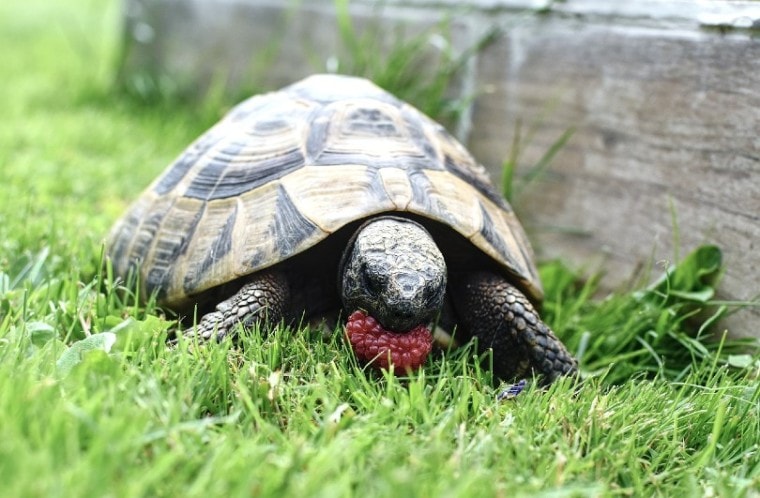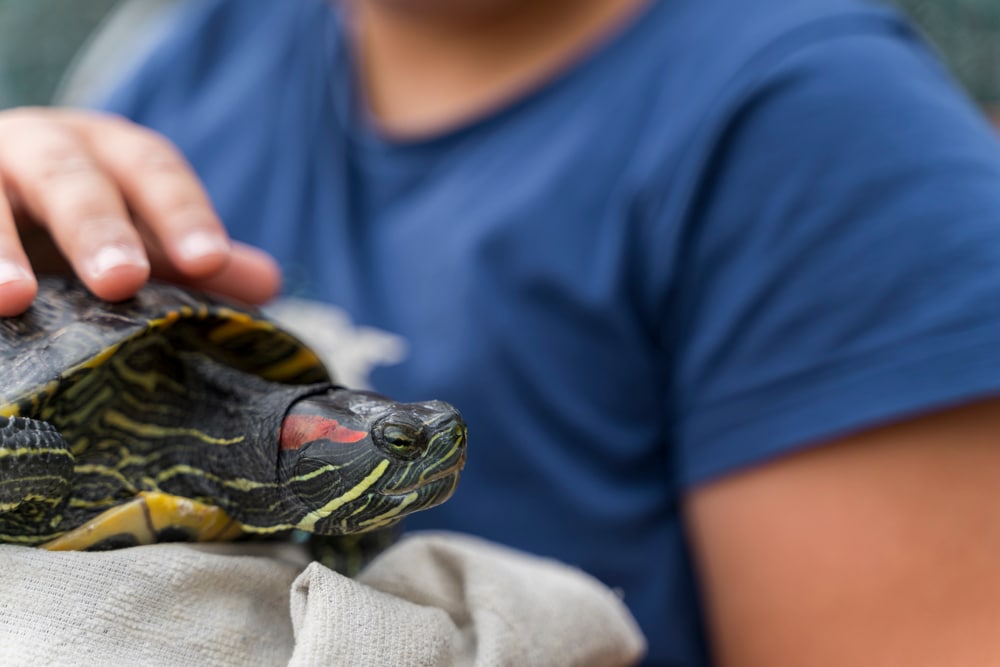
What a tortoise eats will depend entirely on what species of tortoise it is and what part of the world it comes from. And because of this, it’s actually important to know more about what your particular species of tortoise eats when in the wild.
So, we’ll start with a look at the natural habitat and eating habits of different species of tortoises in different parts of the world and what you can feed them at home. We’ll also get into supplements as well as how often you should feed your pet tortoise so you can give them a long and healthy life.
Tortoise or Turtle?
We thought we would start with a look at the differences between a tortoise and a turtle, particularly since there’s usually a lot of confusion between the two. It’s important to know if you have a turtle or tortoise because it does have a significant impact on what they eat.
| Turtles | Tortoises | |
| Legs | Flipper-like front and hind legs | Stocky front and hind legs |
| Feet | Webbed feet | Stumpy, elephant-like feet |
| Diet | Omnivores | Herbivores |
| Habitat | Land and water | Land only |
| Shells | Thinner and flatter | Domed and rounded |
Turtles are semi-aquatic reptiles that are also omnivores, so they typically require more protein than vegetarian tortoises. Turtles will eat small fish and insects and specially made turtle food that’s higher in protein for those that are kept as pets.
Now that you have a basic understanding of the differences between these two related reptiles, we’ll get into the habitats and diets of some of the different species of wild tortoises. Understanding what tortoises eat in the wild will give you a much better idea of what you can feed them at home when keeping one as a pet.

Mediterranean Tortoises
There are a number of tortoises that come from the arid countries surrounding the Mediterranean. Many of these make up some of the most popular tortoises as pets.
Mediterranean Tortoises typically inhabit semi-arid grasslands where they graze on weeds, shrubs, and succulents.
Arid/Tropical Tortoises
These tortoises are in tropical regions that are dry and with less choice of food for them to forage from.
These tortoises graze on food such as grasses, weeds, cacti, stems, leaves, and flowers.
Jungle/Tropical Tortoises
These tortoises are inhabitants of the lush and dense rainforests where they can eat a variety of plants as well as fruit.
These tortoises eat leaves, flowers, fruits, fungi, and grasses, with the occasional amphibians and invertebrates, although this isn’t very common.
Feeding a Pet Tortoise
While almost all tortoises eat certain kinds of food that are pretty similar regardless of where they came from, it’s in the best interests of your pet to have their diet very closely linked to what they would eat in the wild.

Mediterranean Tortoises
If you have one of the species of Mediterranean Tortoises, they will do well with salad greens such as rocket, kale, and baby leaf mixes. However, avoid lettuce like iceberg as it doesn’t offer any nutritional value.
Just be sure these plants haven’t been sprayed with any chemicals or pesticides—in fact, you can grow your own! You can also provide them with flowers and succulents, such as prickly pear, as a part of their regular diet. These kinds of leafy greens should make up about 80% of their entire diet.
Veggies such as broccoli, cauliflower, peppers, and butternut squash are also good but only once or twice a week.
Lastly, a rare treat of fruit would be fun but only once every few weeks, as it could upset their digestive system if you give them too much.
Arid/Tropical Tortoises
The tortoises from these regions, if you remember, tend to come from grasslands and savannas. This makes them grazers; in fact, they are also known as lawn mowers as they will happily munch on your grass in your yard. You can also provide them with the same 80% leafy green diet mentioned for the other Mediterranean species.
The Indian Star Tortoise is the only species that will benefit from a small amount of protein. You can offer them a tiny amount of fish or meat once a week to meet their nutritional needs.

Jungle/Tropical Tortoises
The diet for the Jungle Tortoises can follow the same leafy green vegetables as outlined for the Mediterranean Tortoises, and it should also make up 80% of their diet.
The primary difference is that you can feed them fruit once or twice a week in addition to the other vegetables such as broccoli and cauliflower.
Because these tortoises live in such moist and humid environments, they are occasionally omnivores and therefore do eat some animal material. So, you can add a small amount of protein to their diet, but only about once a week.
If you can’t grow your own food for your tortoise, consider only buying organic. The fewer additives in the food, the better it is for your tortoise’s health.
You can also consider purchasing commercially prepared tortoise food but also use it sparingly. It does add variety, but you shouldn’t depend solely on it.
Water
No surprise, but water is vital to all tortoises. You might not see your tortoise drink water all too often, but it’s just as essential to leave out a clean, shallow dish with fresh water that is changed every day for your pet.
You should also place your tortoise in a shallow bowl of water about once or twice a week for about 10 to 15 minutes. This will give them a bath and ensure that they can take in any necessary water. Filtered water is best since it will remove the chlorine and metals from tap water.

Potentially Dangerous Food for Tortoises
It’s important to know that there are a number of plants and food that can be harmful to tortoises. When a tortoise is grazing, they do tend to stay away from any plants that are bad for them, but you also need to avoid giving your indoor-only tortoise the following items:
Calcium Supplements
Adding calcium to your tortoise’s food is vital as it helps keep the shell strong and helps maintain excellent health. Just avoid any calcium supplements that are high in phosphorus, as it will stop the calcium from being absorbed into the tortoise’s system.
Your best bet is to add a calcium supplement that includes vitamin D (also important for the tortoise) and doesn’t contain any phosphorus.
You can also consider giving your tortoise cuttlebone or a “tortoise block,” but in the long run, a good calcium powder would be best.
Vitamin D
If your tortoise frequently grazes outside in the sun, they will get a nice amount of vitamin D, but the indoor tortoise will need extra.
You can invest in a good UV lamp for your tortoise’s enclosure so they can bask, which will help their vitamin D levels. If you don’t have calcium with added vitamin D, you’ll need to find a separate vitamin D powder that can also be sprinkled on their food.
How Much and How Often?
If your tortoise grazes outside, you don’t have to worry as much about providing set meals. If your yard is lush, you won’t need to give your tortoise as many meals as you would an indoor tortoise.
Most tortoises do well with feeding every other day or just three times a week, but this also depends on the tortoise. You can also provide your tortoise with small but nutritious meals every few days and put them outside to graze.
Just research your tortoise and make sure the food your tortoise is eating is safe—indoors or outdoors. You’ll get to know the right amounts and when it’s time to feed your tortoise and, of course, speak to your vet for any advice.
Summary
Now you have a better idea of what many tortoises eat—both in the wild and in a home as pets. If you have a newly acquired tortoise, you need to do your homework and really read up on the species of tortoise you’ve brought home with you.
Everything about the species and how it interacts in its natural habitat will help dictate what housing, temperature, and, of course, diet for your new pet is suitable and will keep your tortoise healthy and happy.
See also:
- How Often Do Tortoises Eat? Vet-Reviewed Facts & Care Guide
- Can Tortoises Eat Apples? What You Need to Know!
Featured Image Credit: Susanne Edele, Pixabay








